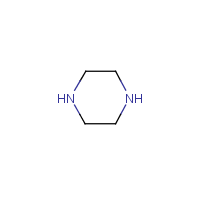Piperazine and salts
Agent Name
Piperazine and salts
CAS Number
110-85-0
Formula
C4-H10-N2
Major Category
Nitrogen Compounds

Synonyms
1,4-Diazacyclohexane; 1,4-Diethylenediamine; 1,4-Piperazine; Antiren; Asca-Trol No. 3; Diethylenediamine; Diethyleneimine; Dispermine; Entacyl; Eraverm; Eraverm (VAN); Hexahydro-1,4-diazine; Hexahydropyrazine; Lumbrical; Piperazidine; Piperazin [German]; Piperazine; Piperazine, anhydrous; Pipersol; Pyrazine hexahydride; Pyrazine, hexahydro-; Uvilon; Vermex; Worm-A-Ton; Wurmirazin; [ChemIDplus] Piperazine salts include dihydrochloride, hexahydrate, citrate, phosphate, propionate, adipate, tartrate, quinate, and sebacate; [ACGIH] UN2579
Category
Piperazines
Description
Colorless solid, hygroscopic, with a pungent odor; [ICSC]
Sources/Uses
Piperazine salts are used as anthelmintic drugs; Also used to make corrosion inhibitors, insecticides, curing agents for polychloroprene, and antihistamines; [HSDB] Used to make fibers, drugs, and insecticides; Also used in veterinary medicine to eradicate pinworms; [ACGIH]
Comments
Corrosive to skin; [Quick CPC] A corrosive substance that can cause pulmonary edema; May cause skin sensitization and asthma after prolonged contact; May cause CNS injury if ingested in large amounts; [ICSC] Salts include dihydrochloride, hexahydrate, citrate, phosphate, propionate, adipate, tartrate, quinate, and sebacate. TLV Basis = respiratory sensitization and asthma; A 1% to 5% solution caused necrosis of the rabbit cornea; Not genotoxic or mutagenic; No teratogenic effects at doses not maternally toxic; Causes tremors and ataxia at doses >45 mg/kg in dogs and cats; NOAEL = 25 mg/kg/day for liver toxicity in dogs; [ACGIH] Causes burns; Inhalation of high concentrations may produce acute pneumonitis and pulmonary edema; [MSDSonline] See "Piperazine dihydrochloride."
Biomedical References
Exposure Assessment
Skin Designation (ACGIH)
No
TLV (ACGIH)
0.03 ppm, inhalable fraction and vapor, measured as piperazine
Vapor Pressure
0.16 mm Hg
Lethal Concentration
LC50 (mice) = 5,400 mg/m3/2h
Explanatory Notes
Flash point = 81 deg C; [CHEMINFO] VP from ChemIDplus;
NFPA
high ambient temp required
Adverse Effects
Skin Sensitizer
Yes
Asthma
Yes
Toxic Pneumonitis
Yes
Neurotoxin
Other CNS neurotoxin
Hepatotoxin
Hepatoxic (a) from occupational exposure (secondary effect) or (b) in animal studies or in humans after ingestion
Dermatotoxin
Skin burns
ACGIH Carcinogen
Not Classifiable
Diseases, Processes, and Activities Linked to This Agent
Diseases
Occupational diseases associated with exposure to this agent: